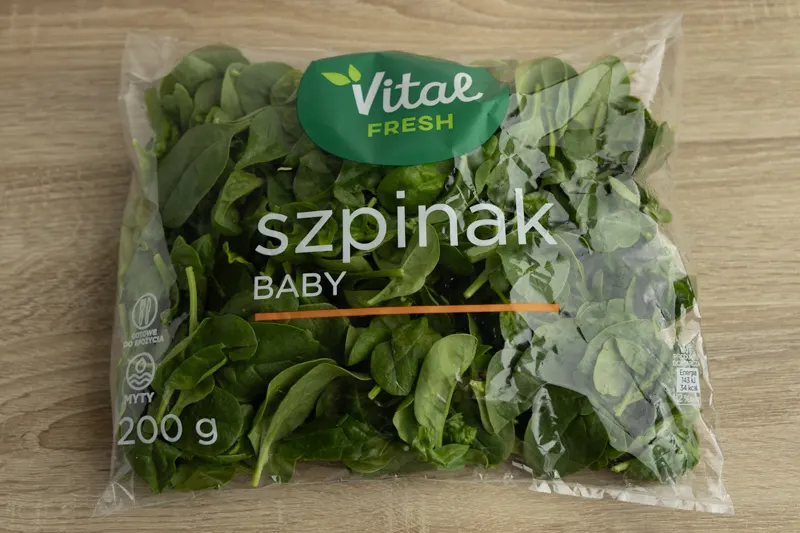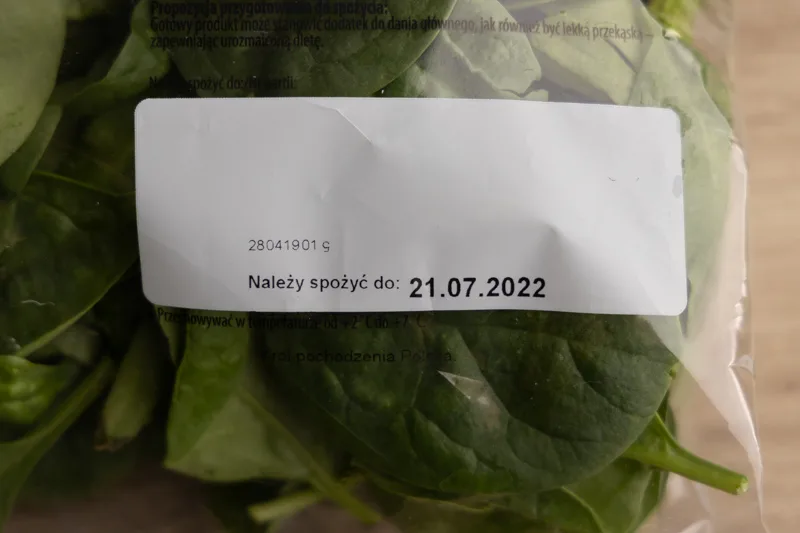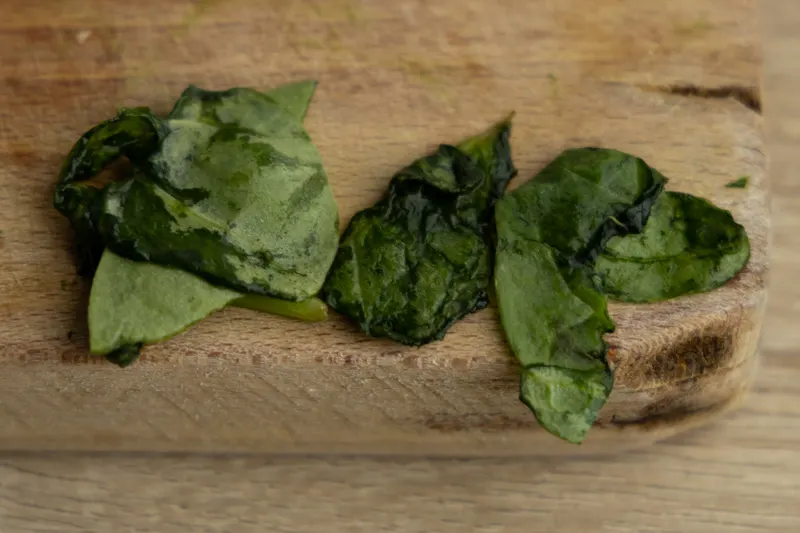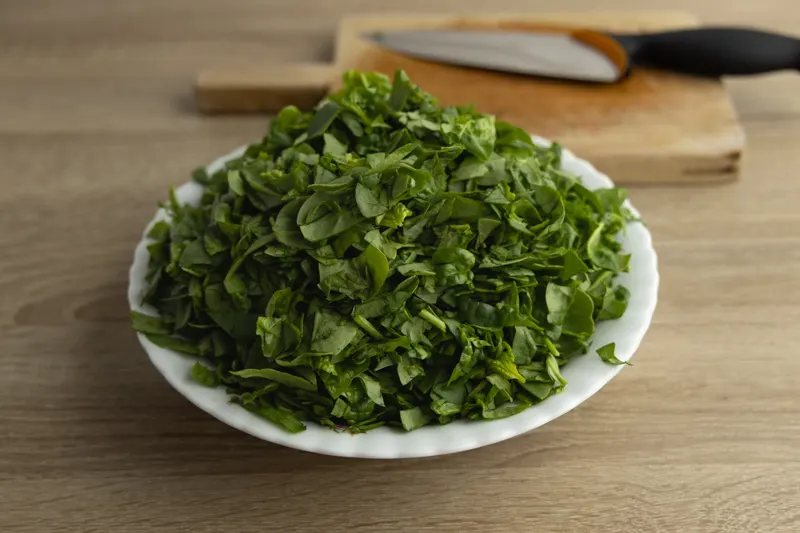In a Nutshell:
- Fresh spinach typically lasts 7-10 days in the fridge, while cooked has a shelf life of about 3-4 days.
- Tell-tale signs of spinach spoilage include a slimy texture, an off-smell, and discoloration.
- Storing spinach properly, i.e., using airtight containers in the refrigerator and not washing the leaves until use, can significantly extend its freshness.
Ever found yourself staring at a bag of spinach and wondering, “how long does spinach last?” Or maybe you’ve got some leftover spinach from last night’s dinner, and you’re unsure if it’s still good.
Look no further!
We’ve put together this handy guide to help you navigate the ins and outs of the shelf life, spoilage signs, and storage methods of spinach.
No need to worry about spoiled greens again and you’ll be able to store spinach like a pro, ensuring every leaf counts. So, let’s dive in and become spinach-savvy, shall we?

How Long Does Fresh Spinach Last in the Fridge?
Fresh spinach lasts 7 to 10 days in the fridge if properly stored. To maintain its freshness, keep it sealed in a storage bag or an airtight container, and add some paper towels to absorb extra moisture.
To make your spinach last as long as possible, follow these storage tips:
- Absorb moisture. Place your fresh, unwashed spinach in a plastic bag or container with paper towels to absorb excess moisture. This helps prevent the leaves from becoming soggy and slimy.
- Give space. Don’t pack the spinach too tightly, and allow some space for air circulation. Containers are better than bags at doing that.
- Allow it to breathe. When using resealable bags, leave a small hole so the spinach and paper towels can breathe. This way, the towels will release some of the absorbed water.
Keep in mind that pre-washed, bagged spinach tends to spoil a bit faster than fresh bunches. So, it’s crucial to use or freeze this type of spinach sooner.
Monitor your spinach daily to check for signs of spoilage, such as wilting, yellowing, or developing a sour smell. It’s best to discard any affected leaves to prevent the spread of bacteria or mold to the rest of the spinach.
(Yes, it’s another case of one bad apple spoiling the bunch.)

Factors Affecting Spinach Shelf Life
When you store spinach, several factors impact its shelf life. By understanding these, you can adjust your storage practices and help your raw spinach last as long as possible.
- Moisture. Raw spinach contains a lot of water, making it prone to spoilage. To keep your spinach fresh, keep it dry and avoid washing it until you’re ready to use it. Also, store it in a way that allows for air circulation and keeps the moisture levels low.
- Temperature. Too high or low temperatures can cause spinach to lose its freshness and quality. To keep your spinach at its best, store it in the refrigerator at around 39°F (or 4°C). This cooler temperature will help slow down the aging process and keep your spinach fresh and vibrant.
- Light. Direct sunlight or artificial lighting may cause spinach to wilt or lose color. Fortunately, simply throwing the bag or bunch in the fridge is enough to protect your spinach from light exposure.
- Ethylene is a naturally occurring gas that some fruits and vegetables release as they ripen. Spinach is sensitive to ethylene, which means exposure to the gas speeds up the ripening process. In plain talk, storing spinach next to fruits and veggies like apples, avocados, bananas, or tomatoes will make it go bad sooner.
By keeping these factors in mind and adjusting your storage practices accordingly, you can extend the shelf life of this leafy green. Or, at the very least, give it a good run for your money. We’ll talk about these factors once again when we discuss storage practices.
With that in mind, let’s talk about cooked spinach leaves.

How Long Does Cooked Spinach Last
Once you’ve cooked your spinach, you have about 3-4 days to enjoy it. Store cooked spinach in an airtight container and in the fridge. Spinach might be a nutritional powerhouse, but it’s not a fan of room temperature for too long after it’s been cooked, so refrigerate it within 1 to 2 hours of cooking.
If you have a large batch of cooked spinach and don’t want it to go to waste, consider freezing it.
Well-packaged cooked spinach can last in the freezer for up to 10 to 12 months. Just be sure to use freezer bags or airtight containers and seal them tightly to retain the veggie’s quality for longer.
When you’re ready to enjoy your spinach, thaw it in the fridge for several hours or overnight, then reheat and serve. You’ll probably need to add some water when reheating so the spinach doesn’t burn.
Also, remember that the quality of your cooked spinach will gradually degrade, especially when frozen. This is because freezing causes small changes in flavor and texture. However, the changes shouldn’t be too drastic, and you’ll still have a healthy and tasty addition to your meals.
To ensure you always enjoy fresh-tasting cooked spinach, try to consume it within the recommended time frame. And when it’s time to reheat your leafy greens, use low heat and keep an eye on them to prevent overcooking.
Next up, let’s talk about spoilage signs.

How to Tell if Spinach Is Bad
Your spinach is bad if it smells off, sour, or musty, is wilting or already slimy, or when the leaves have noticeably discolored. Other than that, trust your senses, as they’ll guide you in determining if it’s time to toss that spinach.
Let’s break those spoilage signs one by one:
- Smell: Give your spinach a sniff. If it has a sour, musty, or off smell, it’s likely spoiled and should be discarded.
- Slimy: When examining your spinach, is it sticky or slimy? This sliminess is a clear indication of bad spinach. Fresh spinach should be crisp and slightly moist, without any sliminess.
- Discoloration: Inspect the leaves for any yellowing or browning. This discoloration is a sign of aging (usually) or rot (rarely), and it’s best to discard it.
- Wilting: Fresh spinach has vibrant and firm leaves. If the leaves are wilting and losing shape, it’s a sign of deterioration.
- Darkened color: A healthy spinach leaf should be bright, vivid green. Keep an eye out for leaves that are turning a darkened color or becoming black, as this indicates spoilage.
Remember always to trust your senses when assessing the quality of your spinach. If your spinach shows any of these warning signs, it’s best to discard it and open up a new bag or grab a fresh bunch.
And in case you were wondering, the same signs show up in spoiled kale.

How to Store Spinach
Keeping your spinach fresh is all about storing it right. Here are some tips on how to store raw spinach, cooked spinach, and even freezing spinach for long-term storage.
Storing Raw Spinach
To store raw spinach, an airtight container is your leafy green’s best mate. First, line the container with paper towels. They’ll act like a cozy, absorbent bed, sopping up any excess moisture that can lead to premature spoilage.
Then, gently place your spinach leaves on top. Remember, spinach is delicate, so handle it with care. Finally, pop another paper towel on top before sealing the container.
This setup, according to TheKitchn, works best for storing greens. Using containers is slightly better than using bags because the leaves don’t get squished together that much, and the wilted and slimy leaves don’t speed up the spoilage of the rest of the bunch.
Of course, if your spinach comes in a sealed bag (that likely has some holes to allow the leafy green vegetable to breathe), leave it as-is until you open the bag.

Freezing Spinach
If you want to extend spinach’s life even more, freezing spinach is a great option.
To do this, you’ll want to blanch the spinach first. This means plunging it into boiling water for a few seconds, then immediately transferring it to ice water to stop the cooking process. Dry the spinach thoroughly, then pack it into freezer bags or containers.
Frozen spinach works great in smoothies, soups, and other cooked dishes, but you probably wouldn’t want to use it in a salad. For those, go with fresh spinach.
Storing Cooked Spinach
Store your leftover cooked spinach or any dish that spinach is a part of in an airtight container, seal it up tight, and refrigerate. And make sure the cooked veggie ends up in the fridge within two hours of cooking.
Cooked spinach appreciates the cold temperature as much as its raw sibling and will keep it happy for 3 to 4 days.
Storing spinach properly is just as important as knowing when it’s time to toss it. With these handy tips, you’ll keep your spinach fresher for longer, making the most out of this nutritious leafy green.